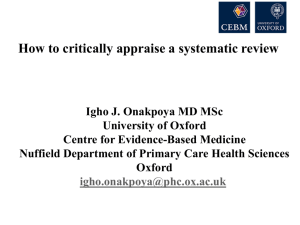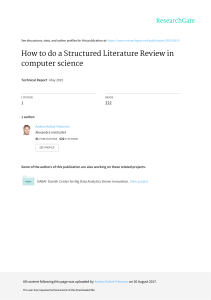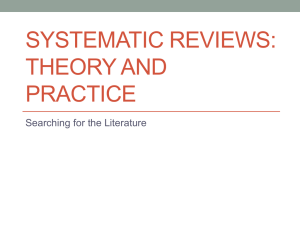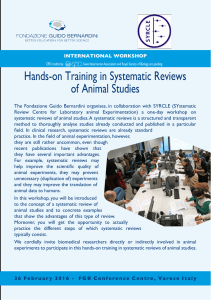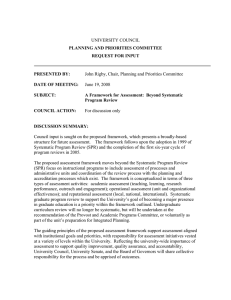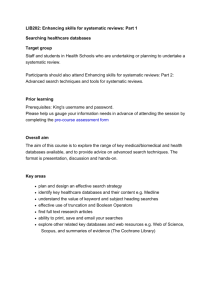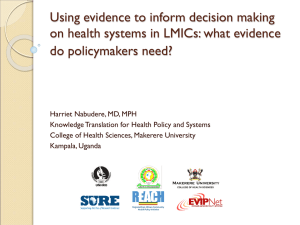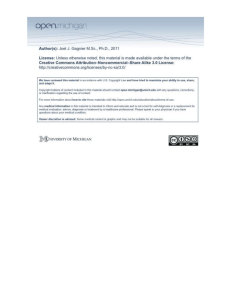E Savage Systematic Reviews
advertisement
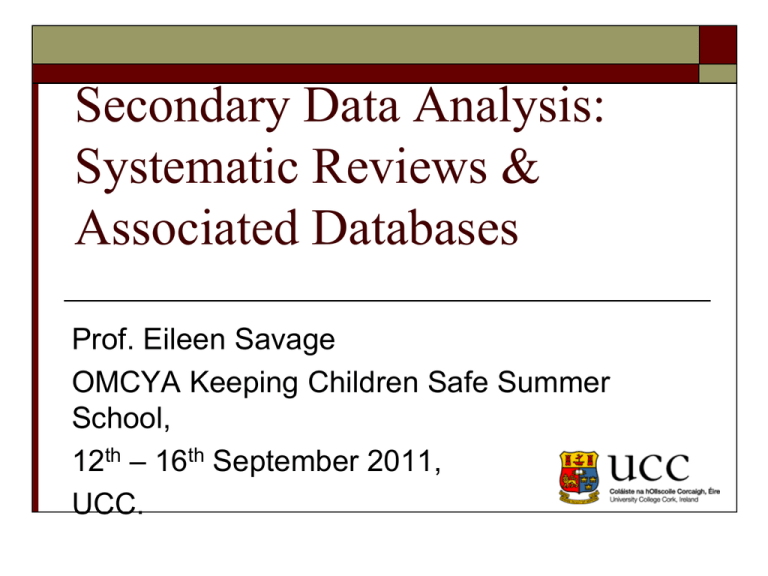
Secondary Data Analysis: Systematic Reviews & Associated Databases Prof. Eileen Savage OMCYA Keeping Children Safe Summer School, 12th – 16th September 2011, UCC. What is a Systematic Review? a concise scientific investigation, with pre-planned methods that summarise, appraise, synthesise and communicate the results of multiple primary studies (Cooke et al, 1997; Centre for Reviews and Dissemination, 2008). ie Research on Research with findings of existing data becoming raw data Differs from a narrative review/ traditional literature review Traditional Review vs. Systematic Review (Nasseri-Moghaddeam & Malekzadeh 2006) Growth of Systematic Reviews Systematic Reviews – Origins of Growth Expanding volume of published & unpublished literature Conflicting findings across studies leading to ‘uncertainty’ Contributes to Evidence Based Movement When to Do a Systematic Review When there is ‘uncertainty’ about the effectiveness of interventions in practice When key questions remain unanswered e.g. about treatments, interventions, practices, experiences etc… To inform practice/policy with best available research evidence To identify what is known/not known in an area to guide future research (includes research methods) (Petticrew & Roberts 2007) Where to find a Systematic Review Peer Reviewed Journals (search bibliography databases) Cochrane Database of Systematic Reviews (Cochrane Library; several Groups) Database of Abstracts of Reviews of Effects (DARE) Health Technology Assessment Database NHS Economic Evaluation Database The Campbell Collaboration Library (Groups e.g. Crime & Justice; Education; Social Welfare; Methods; Communication & internationalization; Users Groups. The Evidence for Policy and Practice Information and Co-ordinating Centre (EPPI-Centre), University of London. (Education; Health Promotion; Employment; Social care; Crime and Justice) Others Structure of Systematic Review e.g. Introduction/Background Questions/Aim & Objectives Criteria for considering studies Search Methods Methods of the Review (e.g screening reading papers; quality assessment; data extraction) Results Discussion Conclusions Criteria for Including/Excluding Studies Types of Studies (see hierarchy of evidence) Types of Participants Types of Outcomes Link to Questions being asked Hierarchy of Evidence Search Method Search Terms Databases +/- Hand searching +/- Reference lists +/-Grey Literature +/- Contacting authors (Refer to Booth et al on standards for Reporting Search Methods) Search Strategy: CINAHL with Full Text (EBSCO) Date of Search Years Covered Complete Strategy 30th March 2011 Date of Search January 1990 to March Years Covered 2011 1. cystic fibrosis.TX. 2. mucoviscidosis.TX. 3. 1 or 2 4. clinical trial.PT. 5. trial.TX. 6. random*TX. 7. 4 or 5 or 6 8. educat*.TX. Complete Strategy 9. program*TX. 10. 8 or 9 11. self care.TX. 12. self-care.TX. 13. selfcare. TX. 14. self management. TX. 15. selfmanagement.TX. 16. manag*.TX. 17. 11 or 12 or 13 or 14 or 15 or 16 18. 10 or 17 Search Strategy: Embase (Elsevier) 30th March 2011 January 1990 to March 2011 1. cystic fibrosis. ti,ab,de. 2. mucoviscidosis. ti,ab,de. 3. 1 or 2 4. 'clinical trial'. ti,ab,de. 5. 'trial'. ti,ab,de. 6. random*'. ti,ab,de. 7. 4 or 5 or 6 8. educat*. ti, ab, de. 9. program*. ti,ab,de. 10. 8 or 9 11. self care ti, ab, de. 12. selfcare. ti,ab,de. 13. self management. ti, ab,de 14. manag*. ti, ab,de. 15. 11 or 12 or 13 or 14 16. 10 or 15 17. 3 and 7 and 16 Methods – Screening for Inclusion/ Exclusion Titles & Abstracts – In/Unsure/Out Read in full –> in/unsure /out Quality Assessment of Individual Studies Quality threshold for inclusion ie exclude poor quality studies Assessment of Quality may be part of SR How - No –’gold standard’ exists - Checklists available e.g. CASP - Quality Scales/Criteria Data Extraction Use a data extraction form (s) 2 or more reviewers / cross-check Extract details relevant to Questions/ Objectives Present raw data in report – table format Data Analysis & Synthesis Collation & summary of results Present in tabular form/forest plots/other + descriptive narrative account +/- Meta-analysis, if appropriate (not possible with heterogeneity ie cannot pool apples with oranges for the purpose of statistical analysis as one data set) Results, Discussion, Implications Critical Appraisal of Systematic Reviews The PRISMA Statement: standards for reporting SRs & Meta-analyses Critical Appraisal Tool Kit for SRs (CASP) Website on Critical Appraisal Tools (covers a range of methods) At: Division of Health Sciences International Centre for Allied Health Evidence http://www.unisa.edu.au/cahe/Resources/CAT/d efault.asp References To follow

